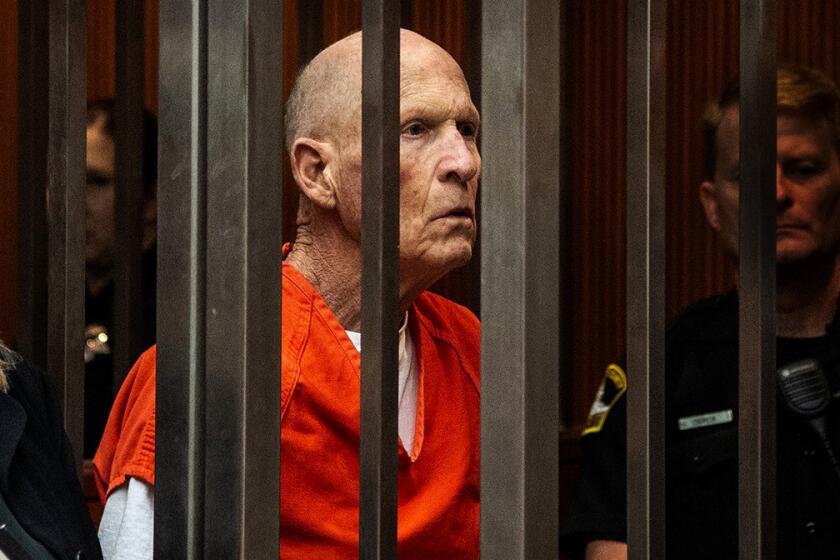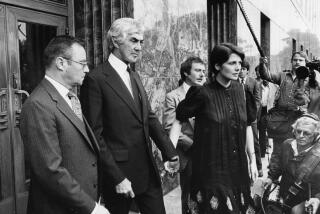An inside look at the Golden State Killer suspect’s behavior
- Share via
Waiting out the COVID-19 pandemic from an RV parked several hours east of Reno, Jim Huddle can’t escape the presence of his brother-in-law.
There is the memory of Joe DeAngelo, relishing his late-night horror movies, clenching his teeth with excitement when the gore started; in a forced whisper, he’d rasp, “Look at that!”
There is the shock of watching DeAngelo pull a gun from the trunk of his car to scare off two men during a parking lot altercation.
And there is the creeping suspicion over flattened bars of gold DeAngelo pulled from a hiding place in the garage that he claimed were melted coins from South Africa.
Now, many years later, Huddle, 69, can’t help but wonder whether they had a darker provenance.
“We were like brothers. He introduced me as his brother,” he told The Times. “It’s kind of a weird thing that someone could be so nice and so evil at the same time.”
To an early love interest, Joe DeAngelo was energetic and worldly. Now, nearly 50 years later, he stands accused of an extended spasm of violence -- home invasions, rapes, murders -- in the 1970s and ‘80s.
On Monday, if everything goes as expected, Joseph James DeAngelo Jr., 74, will plead guilty to 26 criminal charges stemming from 13 murders and 13 rapes. He also will be asked to admit as many as 62 additional crimes related to rapes and other attacks on scores of children, women and men across 10 counties through the 1970s and 1980s.
Prosecutors have agreed not to seek the death penalty for the former Auburn police officer.
The tightly scripted legal proceeding will unfold on a stage in a ballroom at the same Sacramento university from which DeAngelo graduated in 1972 with a degree in criminal justice, along the same river trail detectives believe he traveled to hunt his first victims. The spacious setting was picked because it allows the physical distancing required to guard against the spread of COVID-19. Masks will be required, but those worn by DeAngelo and his lawyers will be clear so the audience can see his face, projected onto two screens on the wall.
One court official, speaking anonymously, said the hearing looks “designed as a reality show.”
Prosecutors say the plea would avoid criminal proceedings that could take years and cost taxpayers more than $20 million.
But the arrangement also means there will be no grand reveal beyond what prosecutors include in their opening remarks. Evidence against DeAngelo remains sealed, leaving victims with only the declaration that a family DNA match linked DeAngelo to crimes that terrorized entire towns.
To an early love interest, Joe DeAngelo was energetic and worldly. Now, nearly 50 years later, he stands accused of an extended spasm of violence — home invasions, rapes, murders — in the 1970s and ’80s.
For now at least, Huddle, a retired Radio Shack clerk and produce inspector, is one of the few people who was inside DeAngelo’s circle who might offer some clues as to the “why” and the “how” behind one man’s alleged explosion of prolonged violence. He is one of the few people with a family connection breaking their silence around a man hunted and eventually marketed as the Golden State Killer.
His slim, self-published book is set for release the day after DeAngelo’s scheduled plea, titled “Killers Keep Secrets.” Huddle said timing is coincidental; publication was set months before the surprise plea deal was reached.
Huddle met DeAngelo in the summer of 1971, when his sister, Sharon, brought DeAngelo home to meet her family. Sharon was 17 and just a year out of high school. DeAngelo was 25, a Navy veteran of Vietnam pursuing a criminal justice degree. Jim Huddle offered to let his sister’s boyfriend move in with him. Just weeks earlier, DeAngelo told him another woman had broken off their wedding engagement.
Even as he pursued a relationship with his sister, Huddle said, DeAngelo continued to obsess over Bonnie Colwell. “He would say, ‘Yeah, that Bonnie, she broke my heart,’ and ‘She was the love of my life.’ Apparently it tore him up so much he couldn’t love Sharon like he loved her,” Huddle said in an interview with The Times.
Huddle never knew that Bonnie rejected DeAngelo because of what she described as a pattern of abusive treatment, including pulling a gun on her to force her to marry him. He also was unaware that nine years later, rape victims described a weeping, unstable attacker who sometimes cried, “I hate you, Bonnie!”
DeAngelo married Sharon Huddle in 1973 while working as a police officer in tiny Exeter, Calif., shortly before a series of bedroom ransackings began in neighboring Visalia. The manic nightly break-ins culminated in the 1975 attempted bedroom abduction of a young teen while her family slept, and the murder of the girl’s father when he interrupted the attack.
The brothers-in-law shot guns and raced dirt bikes and motorcycles. DeAngelo hated having his picture taken. He tended to fabricate stories that made him look important.
He described the day DeAngelo opened his wife’s antique stove in the garage and pulled out a cloth bundle. Wrapped within a towel were pancake-sized patties of melted gold and a small, hand-cast gold bar. Huddle said DeAngelo told him he had melted down South African Krugerrands, bought by making high-interest loans to fellow sailors during the war in Vietnam.
Huddle said he now suspects the gold was cast from the coins and jewelry DeAngelo is accused of stealing from hundreds of victims. Investigators have never recovered what they said were a killer’s trophies.
Over the course of 40 years, DeAngelo never seemed to share deep feelings, Huddle said. DeAngelo came across as “plastic” and “fake.”
“He was never a real heartwarming person,” Huddle said.
After being fired as an Auburn police officer for shoplifting at a hardware store, an angry DeAngelo told him he wanted to kill his former police chief, Huddle said.
“I mean, my God, you’re just talking crazy,” Huddle recalled telling his brother-in-law. He said he warned DeAngelo: “You’re not going to get away with that. ’Cause they’re gonna always be looking for the guy who did that.”
After DeAngelo lost his job in Auburn, the East Area rapes in Central California stopped, and a series of rape-related murders in Southern California began.
The crime shift coincided with Sharon Huddle’s hiring by the National Labor Relations Board in Los Angeles. She and her husband rented a house in Long Beach, Jim Huddle confirmed, while documents obtained by The Times show DeAngelo collected payments from the state of California for job retraining. He began a second career as a diesel mechanic.
Both men had daughters near the same age, and DeAngelo would take the girls out at night to play in the darkness of a closed park. Sometimes, he’d watch horror films with the girls until daybreak. “He was like, ‘Oh, it won’t bother them, Jim,’” Huddle said.
Victims of the man raping scores of women in the Sacramento suburbs in the late 1970s described hearing a similar gravelly whisper forced between clenched teeth.
Huddle has a photograph from the period, one of his daughters perched on the lap of DeAngelo in his new suburban home at Citrus Heights. A photo of his wife nursing their new baby hangs on the wall behind them.
It was spring 1983 when, after 50 rapes and 12 increasingly bloody murders, the chain of crimes suddenly stopped. Five years later, there would be a final rape attack and the killing of a teenage girl at home alone.
DeAngelo called Huddle’s parents “Mom” and “Dad” and came around to check on them even after Sharon moved out in 1990 with their three daughters. She finally divorced DeAngelo in 2019, securing his house and his monthly Teamsters pension under an otherwise confidential settlement. Aside from a brief statement expressing sympathy for victims, Sharon Huddle has steadfastly refused to comment.
With his self-published book, paid for out of pocket, Huddle is part of the widening commercial orbit around the notorious serial-killer case.
On a much larger and lucrative scale, the night before the plea hearing, HBO is to begin a six-part dramatization of late crime writer Michelle McNamara’s efforts to unmask the cold-case criminal she rebranded as the Golden State Killer. Her book “I’ll Be Gone in the Dark” was released two months before DeAngelo was arrested.
The HBO series of the same name draws from three dozen banker boxes of evidence files the writer carted off from an Orange County police evidence room and tape recordings she made of confidants, but the focus is primarily on McNamara.
Some of the victims are taken aback. The sister of murder victim Janelle Cruz publicly shared a copy of HBO’s note warning her of “graphic imagery and information” while saying “it has been so meaningful to connect with you.”
“I didn’t even speak to them about this,” Michelle Cruz posted on Twitter.
Jennifer Carole was distressed, while watching HBO’s preview, to see the naked, bloody bodies of her father and stepmother — Lyman and Charlene Smith — and the shattered pieces of the fireplace log used to crush their skulls.
The crime-scene photos were among open investigation files McNamara obtained from police.
“I’m deeply disturbed anyone outside law enforcement had access to these files,” Carole said.
The HBO production also came with nondisclosure agreements with crime victims, paid interviews and catering of a garden party that is the stage for the finale of the series.
Kris Pedretti, 15 when she was raped and tormented in 1976 by someone who was then called the East Area Rapist, said the two-year parade of arrest, criminal hearings and myriad news stories, podcasts — including one by The Times — cable news shows, books, true crime conventions and other spinoffs has been overwhelming.
“My emotions right now, through this live reality show ... can be compared to a roller coaster,” Pedretti said. “As soon as the balance returns from the last DeAngelo news, a new roller coaster appears, each time with more tight turns and steep slopes.”
Some of the families of the victims have found a public voice. Pedretti, once prevented by her father from ever discussing her rape, has started a private Facebook group for sexual assault survivors.
Carole documents the progression of the case through a blog and a podcast, and said her 400 followers share her ambition to look beyond crime as entertainment.
Former Air Force officer Jane Carson was the first of the East Area rape victims to speak publicly and wrote a book describing her rape and encouraging rape victims to report their attacks and seek support and counseling.
Carson voiced anxiety about the plea hearing Monday — about the banks of media cameras and the large hall; about sitting masked and far apart from her fellow survivors, in order to see DeAngelo admit to her 1976 rape.
“I just wish it were in a much smaller setting and a much more personal setting, because I want to hear him admit to every one of his crimes,” she said. “It’s going to be such a circus. I just wish it were over.”
More to Read
Sign up for Essential California
The most important California stories and recommendations in your inbox every morning.
You may occasionally receive promotional content from the Los Angeles Times.












